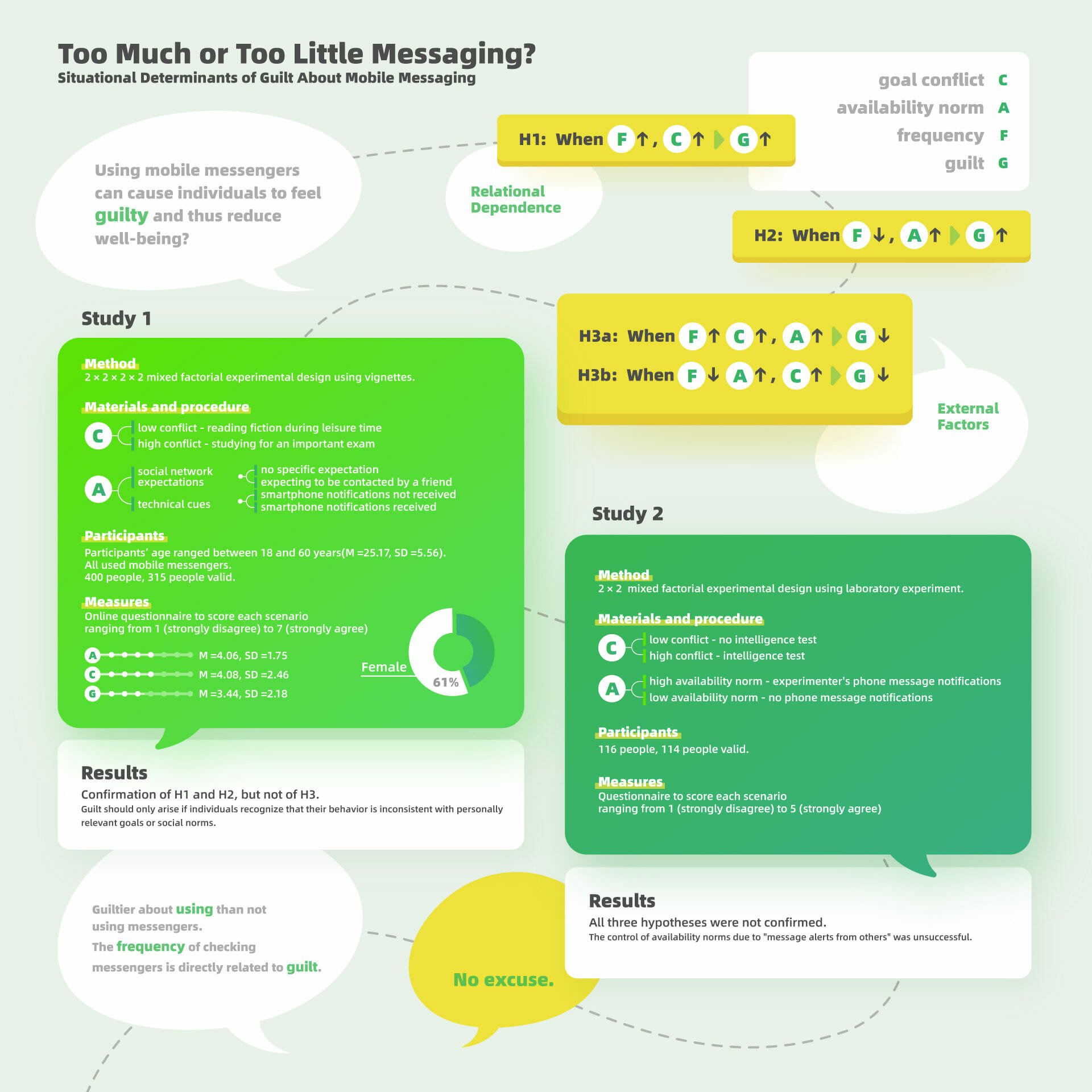信息太多或太少?关于移动信息的内疚感的情景决定因素
有研究表示,使用移动通信工具会使个体产生内疚感,从而降低幸福感。正如自我决定理论所阐述,个体在充分认识个人需要和环境信息的基础上,对自己的行动做出自由的选择。但是是什么影响了我们使用通信工具?移动通信工具又如何影响人的感觉?为了全面地探讨这一话题,本文的作者依据前人的研究总结提出了两个因素:目标冲突和社会规范的显著性。
首先,通信工具可能使我们产生关系依赖感,从而偏爱使用社交媒体,这便产生了“目标冲突”。例如学习与玩手机就是一对冲突目标。因此作者提出第一个假设,当频繁地使用通信工具时,目标冲突越高,个体就会产生更多的内疚感。好比你在考试前夜不停地与朋友微信聊天而不是复习,会比平日产生更多的内疚感。
接着,许多研究表明,个人对不维护人际关系或延迟回复电话或信息感到内疚,这便是可行性规范的作用。社会普遍规范要求人们定期检查手机和回复消息,个体会将其内化成自己的压力。因此作者提出了第二个假设,当较少使用通信工具时,规范的显著性越高,个体就会产生更多的内疚感。
最后,有研究发现,人们为了减少内疚感,会把自己过多或过少使用通信工具的原因归结于外部因素。这便形成了第三种假设,即移动通信工具的使用频率、目标冲突和规范显著性三者存在相互影响的关系。考试前夜不停地与朋友微信聊天而不是复习,会比平日产生更多的内疚感,这是假设一的内容,然而,当你给自己一个借口,说“ta是我非常重要的朋友,我应该回复ta”,那么此时你的内疚感就会降低。假设二也是同样的道理,这两个假设的变种组成了假设三。
.
那么让我们看看作者是如何验证这三个假设的。
首先,研究者进行了一个叫做“小插曲”的2 × 2 × 2 × 2混合因子实验,就是把一些情境用文字列出来,做成问卷,让被测者给这些情境下自己的内疚程度打分。“为重要的考试复习”和“在闲暇时间阅读小说”代表目标冲突的高低。而可行性规范的显著性则通过两种方式控制,一种通过社会网络期望,即被测试者是否期望被朋友联系,另一种通过技术线索,即是否收到智能手机的消息通知。被测试者会被随机分到两个版本中的一个,然后对各自八个情景作出反应。
数据结果证实了假设一和假设二的成立,而假设三的数据没有呈现出显著差异。作者提出,造成这种情况的原因可能是参与者并没有实际经历引起内疚的情况,可能表明小插曲实验的人为性影响了结果。
.
因此,作者进行了第二次实验——实验室实验。
这次试验采用了2 × 2的主体间设计,将目标冲突和规范显著性高低分为了四个场景,每个被测者被随机分配到一个场景。目标冲突的高低由测试练习来控制,一个房间宣布让被测试者在等待期间进行练习,形成高目标冲突。而另一个房间则不需要进行测试练习,从而形成低目标冲突。对于可行性规范,由工作人员的手机传来明显的消息提醒而形成高可行性规范的显著性,而在低可行性规范的场景下,工作人员则保持安静。
20分钟后实验结束,被测者通过填写量表来表达自己的内疚程度。然而数据表明,可行性规范的变量控制并不成功,因此无法采用相关数据。而对于假设一,数据没有显著差异。因此,三个假设在第二次实验中均没有被证实。作者对出现此结果的原因进行了分析,总的来说,在实验室环境的内疚感水平比小插曲实验调查的要低很多。
.
这两次实验得出了两个共同的结论:
第一,没有证据表明目标冲突、可得性规范的显著性和信使的使用在影响内疚方面有相互作用。然而,可以进一步调查是否有一些应对策略可以减少对信使使用的愧疚感。
第二,个人对于使用通信工具比不使用更有罪恶感,而且检查消息的频率与内疚感直接相关。这与目前社会上对媒体使用的评价形成了共鸣。拿起手机发信息可能代表了一种”有罪的快乐”,而不这样做可能会被积极地评价为短暂的”数字排毒”或成功的自我控制的表现。
Introduction
Too Much or Too Little Messaging? Situational Determinants of Guilt About Mobile Messaging.
Some studies have indicated that the use of mobile messengers can cause individuals to feel guilty and thus reduce well-being. As Self-Decide Theory (SDT) explains, individuals make free choices about their actions based on a full awareness of their personal needs and information about their environment. But what influences our use of messengers? And how do mobile messengers affect people’s feelings? In order to explore this topic comprehensively, the authors of this paper proposed two factors based on the summary of previous research: the experience of goal conflict and violations of the availability norm.
Firstly ,communication tools may create a sense of relational dependency that leads to a preference for social media, creating a “goal conflict”. For example, studying and playing on the phone are conflicting goals. Therefore, the authors propose the first hypothesis that the higher the goal conflict, the more guilt individuals will feel when using messengers frequently. It’s as if you keep chatting with your friends on WeChat the night before an exam instead of revising, which will create more guilt than usual.
Secondly, a number of studies indicate that individuals feel guilty about not checking interpersonal channels or responding late to calls or messages. This is where the availability norm comes into play. The social norms require people to regularly check their phones and respond to messages, which individuals internalize as their own pressure.The authors therefore proposed a second hypothesis, that the higher the salience of the norm, the more guilt individuals will feel when using messengers less frequently.
Finally, it has been found that people attribute their excessive or infrequent use of messengers to external factors in order to reduce their guilt, which leads to the third hypothesis proposed by the authors that there is an interaction between frequency of mobile messengers use, goal conflict and norm salience relationship. The night before the exam constantly chatting with friends on WeChat instead of revising will produce more guilt than usual, which is the content of hypothesis one. However, when you give yourself the excuse that “(s)he is a friend who is very important to me, and I should reply to her/his messages”, then your guilt will be reduced.The same is true for hypothesis two, and variants of these two hypotheses make up hypothesis three.
.
So let’s see how the authors test these three hypotheses.
First, the researchers conducted a 2 × 2 × 2 × 2 mixed factorial experiment called “vignette”.It is to list some situations in words, make a questionnaire, and ask the respondent to rate his or her level of guilt in these situations.
“Studying for an important exam” and “reading fiction during leisure time” represent high and low levels of conflicting goals.The availability norm was controlled in two ways, one through social network expectations, which is the participants expected to be contacted by friends, and the other through technical cues, which is they received a message notification from their smartphone. Participants were randomly assigned to one of the two vignette versions and then responded to each of the eight scenes within the respective condition.
The data results confirmed the validity of hypotheses one and two, while the data for hypothesis three did not show significant differences.The authors suggest that reasons for this could be that participants did not actually experience guilt-inducing situations, which could indicate that the artificiality of the vignette experiment influenced results.
.
Therefore, the authors conducted a second experiment – the laboratory experiment.
The experiment used a 2 × 2 between-subjects design in which the target conflict and normative salience were divided into four scenes, and each participant was randomly assigned to a scene.The level of goal conflict was controlled by test practice, with one room announcing that the test subject would be allowed to practice during the waiting period, creating a high goal conflict. In contrast, the other room did not require test practice, resulting in a low goal conflict.For the availability norm, the salience of the high availability norm was formed by a visible message alert from the experimenter’s cell phone, while in the low availability norm scenario, the experimenter was kept quiet.
After 20 minutes the experiment ended and the participant expressed their level of guilt by filling out a scale. However, the data showed that the variable control of the availability norm was not successful and therefore the relevant data could not be used.For hypothesis one, there was no significant difference in the data results. Thus, all three hypotheses were not confirmed in the second experiment. The authors analyze the reasons for this result, overall, guilt levels were considerably lower in the laboratory setting than in the stereotypical scenarios in the vignette experiment.
.
These two experiments led to two common conclusions.
First, there was no evidence that goal conflict, availability norm salience, and messenger use interacted in influencing guilt. Nevertheless, it should be further investigated whether there are coping strategies that can reduce feelings of guilt about messenger use.
Second, individuals feel guiltier about using than not using messengers and that the frequency of checking messengers is directly related to guilt. This resonates with the current social commentary on media use. Put differently, grabbing the phone to message may inherently evoke more guilt because it represents a “guilty pleasure”, while not doing so may be evaluated positively as a brief “digital detox” or a demonstration of successful self-control.
信息可视化图(Infographic)

Comments
终于结课啦!FREEZhao上课很轻松有趣,不过要想真正读懂文献、再转而讲述给他人,还是挺需要付出时间精力的::>_<::
头一回读英文学术文献,感觉选了一节英语课。一开始真的很有难度,一句话里十个词八个不认识,但第一次不靠大段翻译,把全文脉络理清的那一瞬间,成就感爆棚!而且以前读论文都只是读个大概,从来没有过这种拎清主干结构、再深入“研读”的经历,学到了很多知识!
视频我选择了动画的形式讲解,不过我没有预估好做动画的时间,导致最后三天非常非常赶,光是英文的旁白就花费了我这个英文白痴一整天〒▽〒。如果重来一次,我一定从第二周就开始构思视频脚本!
最后想说,很喜欢 FREEZhao的教学风格,与同学们非常亲近,共同学习、共同进步,思想也非常开放哈哈哈哈包容性很强!杰克快乐!
原文
Halfmann, A., Meier, A., & Reinecke, L. (2021). Too much or too little messaging? Situational determinants of guilt about mobile messaging. Journal of Computer-Mediated Communication, 26(2), 72-90.

发表回复